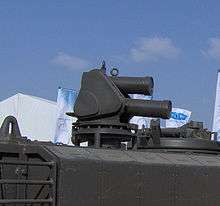Iron Fist (countermeasure)

Iron Fist (Hebrew: חץ דורבן, Hetz Dorban, lit. Porcupine Arrow) is a hard-kill active protection system (APS) designed by Israel Military Industries (IMI), with a modular design allowing adaptation to a range of platforms ranging from light utility vehicles to heavy armoured fighting vehicles. The concept was revealed by IMI in 2006 and was expected to enter Israel Defense Forces tests by mid-2007. The system has been successfully tested against a wide variety of threats including rocket-propelled grenades, anti-tank guided missiles and tank-fired HEAT ammunition and kinetic energy penetrators.
It senses incoming threats via a fixed radar sensor developed by RADA Electronic Industries and an optional passive infrared detector developed by Elbit's Elisra. When a threat is imminent, an explosive projectile interceptor is launched towards it. The interceptor explodes very near the threat, destroying or deflecting and destabilizing it without detonating its warhead. For this, only the blast effect of the explosive is used. The interceptor casing is made of combustible materials so no fragmentation is formed in the explosion, helping minimize collateral damage.
Acquisition of the Iron Fist active protection system was approved in June 2009. The system was to be installed on the Namer armoured personnel carrier.[1]
In November 2010, The Israeli ministry of defense announced the stop of funding of the system development.[2][3]
In May 2011, the system intercepted Kinetic energy penetrators and Metis anti tank missiles during a test in the U.S.[4]
In early 2013, the MoD tested both the IMI Iron Fist and Rafael Advanced Defense Systems Trophy in a competition to select a single second-generation APS for IDF vehicles. Both systems were first-generation standard at the time. Both systems were financed concurrently until 2010, when the ministry's participation in funding the Iron Fist was suspended and limited procurement of the Trophy was initiated. In 2012, the ministry attempted to combine the two systems into one, utilizing the Iron Fist's interceptor and the Trophy's Elta radar and C3 system. Because Rafael would serve as the prime contractor instead of both companies being equal partners, IMI refused to cooperate. After 2013 trials, completion of a second-generation APS would be completed within a few years. IMI is also trying to market the Iron Fist internationally.[5]
In December 2014, it was revealed that Rafael, Israel Aerospace Industries, and IMI had agreed to jointly develop a next-generation active defense system for vehicles, based on a combination of the Rafael/IAI Trophy and IMI Iron Fist. Rafael will act as the main contractor and system developer and integrator, and IAI and IMI will be subcontractors providing the radar and interceptor respectively. Unlike the Trophy's interception method of metal pellets that spread over a wide area, IMI's interceptor is based on an anti-missile missile. Interest for a vehicle APS grew significantly following Trophy's successful performance during Operation Protective Edge in mid-2014, where tanks equipped with the system intercepted dozens of ATGMs and RPGs, and suffered no injuries or false alarms. The Defense Ministry had pushed the companies to work together and combine their systems.[6]
In June 2016, the U.S. Army chose the Iron Fist Light configuration to protect its light and medium armored vehicles as part of the Modular Active Protection System (MAPS) program. The decision to select Iron Fist was made because of the system’s light weight, ability to fire interceptors without shock, and low cost.[7][8]
References
- ↑ "IDF Approves Acquisition of IMI's Iron Fist Active protection Systems for Namer AIFVs". Defense Update. June 2009. Retrieved 10 August 2014.
- ↑ Amos Harel (10 November 2010). משרד הביטחון הפסיק לממן פיתוח מערכת הגנה לנגמ"שים [Defense Ministry ceased financing the development of a protective armored personnel carriers]. Haaretz (in Hebrew). Retrieved 10 August 2014.
- ↑ Amos Harel (24 December 2010). "הארץ" חושף: מערכת ההגנה מטילי נ"ט מוקפאת, ונגמ"שי החי"ר מחכים למיגון [Haaretz reveals: antitank missile defense system is frozen, and waiting infantry protection APCs]. Haaretz (in Hebrew). Retrieved 10 August 2014.
- ↑ "First Report: Iron Fist System Intercepted Kinetic Shell in a Trial in the United States". Archived from the original on May 7, 2011. Retrieved June 8, 2011.
- ↑ Rafael's Trophy and IMI's Iron Fist to Compete in Early 2013 - Israeldefense.com, 23 December 2012 Archived October 18, 2013, at the Wayback Machine.
- ↑ Rafael, IAI and IMI to jointly develop next-generation of active defense system for vehicle - Armyrecognition.com, 30 December 2014
- ↑ U.S. has chosen Israeli Iron Fist active protection system to secure armoured personnel carrier - Armyrecognition.com, 9 June 2016
- ↑ US Army selects Israel Military Industries for APC active protection system - Jpost.com, 7 June 2016
External links
- Israel Military Industries Ltd: Active Protection System, Iron Fist
- Armada, issue 4/2007, August/September: Unrivalled Active Protection System (APS) Against the Widest Range of Threats
- "Iron Fist Active Protection Ssystem (sic) (APS)". Defense Update. January 2006. Retrieved 10 August 2014.